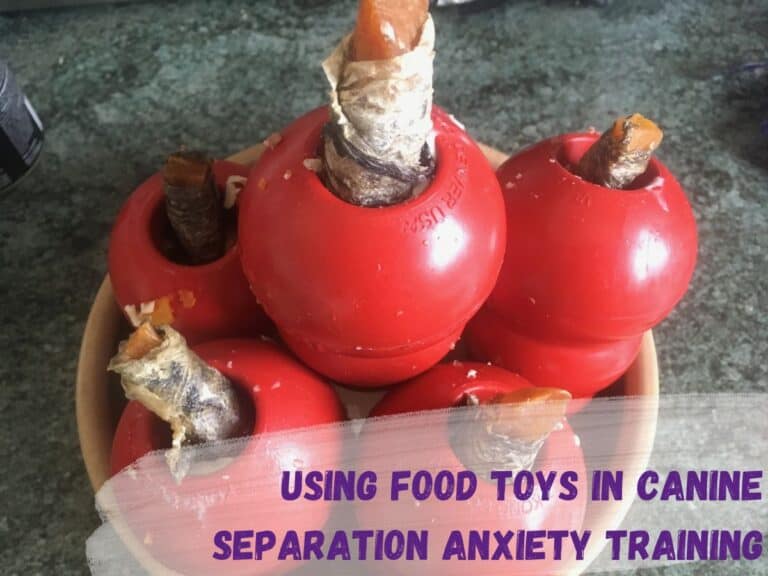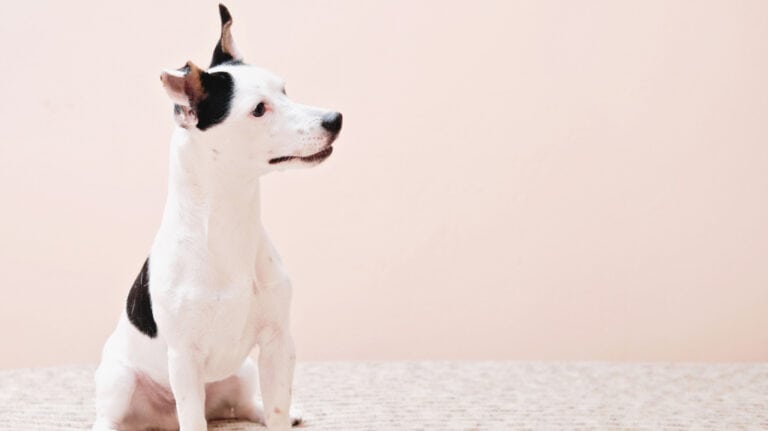My Dog Destroys the House When I Leave – How Do I Stop This?
The Pet Coach features affiliate links and participates in the Amazon Services LLC Associates Program. If you choose to make a purchase through one of these Amazon links, I may earn a small commission—at no additional cost to you. These affiliate earnings help support the website and allow me to continue providing free content for pet parents. For more details, please see my disclosure policy.
Separation anxiety showing up as destructive behaviour in dogs is more common then you think! Yes, if you're coming home to a disaster zone courtesy of your beloved dog, you're not alone. Many dog owners face the challenge of destructive behaviour when they leave their pets alone. It's frustrating and can be costly, but there's hope.
Understanding why your dog is being destructive this is the first step to solving this problem. Is it anxiety, boredom, or something else entirely? Once you've identified the root cause, and the emotion that's driving your dog to do this, you can implement targeted strategies to help your pup cope with your absence. From exercise routines to creating safe spaces, there are numerous ways to address this issue.
If you want help right away book a call with me, you can learn more over on the main separation anxiety page, or check out the about me page.
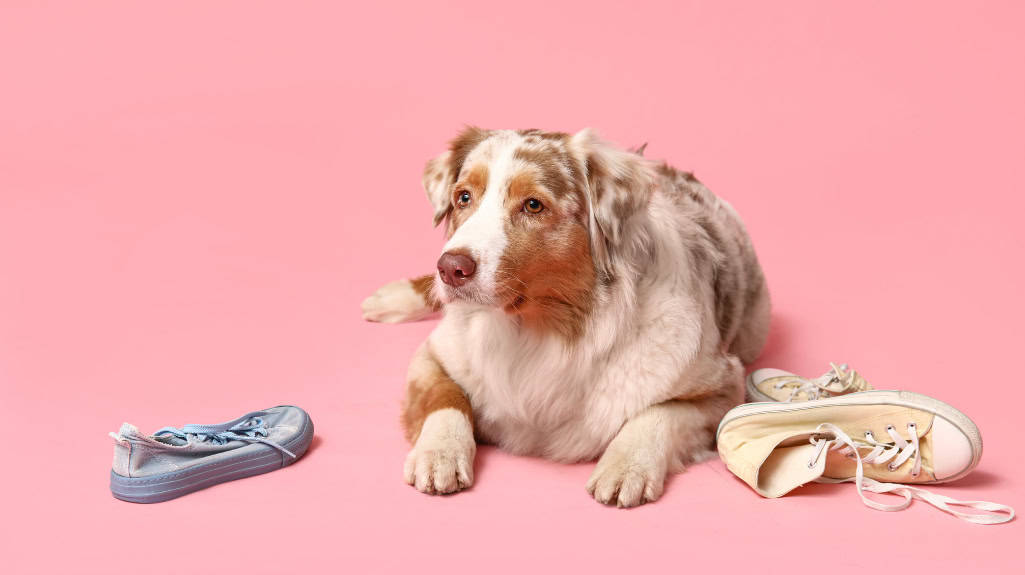
Understand the Root Cause of Destructive Dog Behaviour
Before you can stop your dog from destroying the house, you've got to figure out why they're doing it. Destructive behaviour often stems from separation anxiety, a common issue that manifests when dogs are left alone. Look for signs like pacing, whining, or excessive chewing when you're about to leave or shortly after your departure.
If your dog is under six months old, their destructive tendencies might be linked to teething. Puppies naturally explore their environment with their mouths, so provide appropriate chew toys to redirect this behavior.
For older dogs, boredom can be a significant factor. Without proper stimulation, they may resort to shredding furniture or other household items for entertainment.
Consider your dog's energy level and breed characteristics. High-energy breeds require consistent exercise and mental engagement to prevent pent-up energy from turning into destructive actions.
Identify potential triggers, such as loud noises or changes in routine, that might be exacerbating your dog's behavior. By pinpointing the root cause, you'll be better equipped to implement effective strategies to curb your dog's destructive habits.
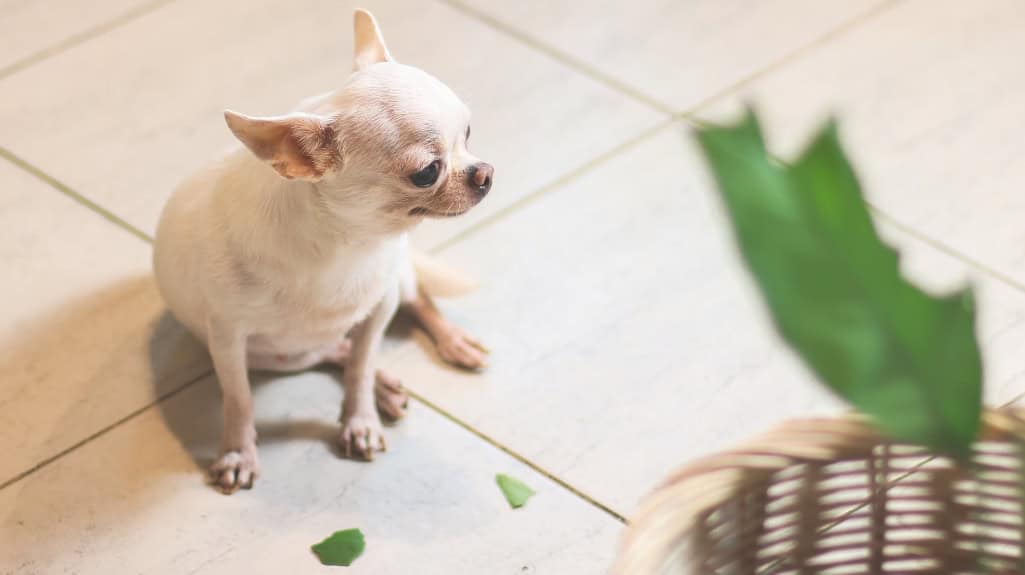
Exercise Your Dog Before You Leave
Do I need to tell you most dogs benefit from daily walks? Having identified the root cause of your dog's destructive behaviour, it's time to implement a powerful prevention strategy: exercise before you leave.
Start each day with a 30-45 minute walk to release your dog's pent-up energy, significantly reducing the likelihood of mischief when left alone. Don't just stick to the same route; vary your paths to provide both physical exercise and mental stimulation. This combination keeps your dog engaged and less prone to boredom-induced destruction.
Consistency is key. Establish a morning exercise routine to create a sense of predictability for your dog, alleviating anxiety associated with your departure.
Remember, a tired dog is more likely to associate your leaving with rest, rather than engaging in destructive activities. To maximise the effectiveness of your pre-departure routine, consider incorporating additional play, such as cardio games. This extra physical exertion further ensures your dog will be content to relax during your absence.
Mental stimulation is also a big part of making sure your dog's needs are met, so sniffy walks, blind retrieves, and playing hide and seek, will all add to reducing boredom and giving them an outlet for their breed specific needs.
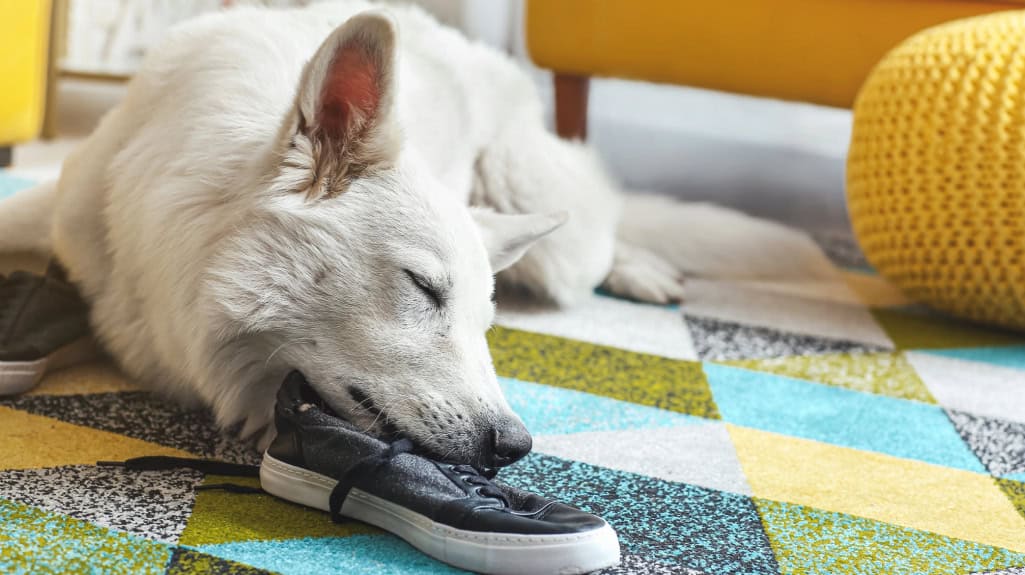
Create a Safe Space
Creating a safe space for your dog is a crucial step in preventing destructive behaviour. Designate a specific area in your home, using baby gates or crates to limit access to potentially hazardous areas. This confined space should be equipped with comforting items like blankets and approved toys, serving as a sanctuary that soothes anxiety and curbs destructive tendencies.
Incorporate familiar scents, such as your clothing or a favourite blanket, or some dogs do well with Pet Remedy or other pheromone based products likes Adaptil. This olfactory comfort can significantly reduce stress levels when you're away.
Provide an enriched environment, regularly rotating the toys within the safe space, so your dog gets variety. This helps to stimulate mental engagement and provides a positive outlet for your dog's energy.
Provide Engaging Toys
Engaging toys are a powerful tool in preventing your dog from destroying the house. By providing a variety of stimulating options, you'll redirect their energy and attention away from household items.
Start with KONGs filled with peanut butter or yogurt, which offer a long-lasting challenge. As they get more skilled at emptying the Kong, try freeze them to extend the empty time, and keep your dog occupied for longer periods.
Change up your dog's toys regularly to maintain interest and combat boredom. Introduce puzzle toys that require problem-solving skills, stimulating your dog's mind and reducing stress-induced destructive behaviour. These mental exercises are particularly effective in alleviating anxiety when you're away.
For maximum impact, create a diverse toy collection that includes chew-friendly options and interactive games. This enriched environment encourages appropriate chewing behaviours and discourages the targeting of furniture or personal belongings.
Remember to tailor your selection to your dog's preferences and chewing habits. By consistently offering these engaging alternatives, you'll help your dog develop positive habits and reduce the likelihood of destructive episodes, ensuring a more harmonious home environment for both of you.

Gradual Departure Training
If your dog is experiencing separation anxiety or isolation distress then gradual departure training is a crucial step in helping your dog overcome this and destructive behaviour. This technique involves systematic desensitisatio, teaching your dog to cope with being alone, starting with brief absences and gradually extending the duration.
Begin by figuring out your dog's threshold – home CCTV or pet cameras will be needed for this. For some leaving your dog for just a few minutes is ok, while others will struggle with just seconds, whatever your dog's threshold we need to ensure they remain under it and calm throughout. Slowly increase the time you're away, always monitoring their behaviour. Use the cameras to observe your dog's reactions and adjust your training accordingly. Remember, progress may be slow, but consistency is key.
Incorporate positive reinforcement into your training routine may work for some dogs. Reward your dog with treats or praise when they stay relaxed during your departures. This reinforces the idea that being alone isn't a negative experience, though it is more of an ‘active style of training' and really we are looking for relaxation.
To make alone time more enjoyable, provide engaging distractions like puzzle toys or chew items. I often recommend this with puppies, who are mostly not trained to be comfortable alone, or are just bored.
Throughout the process, pay close attention to your dog's comfort level. If they show signs of distress, reduce the duration and progress more slowly.
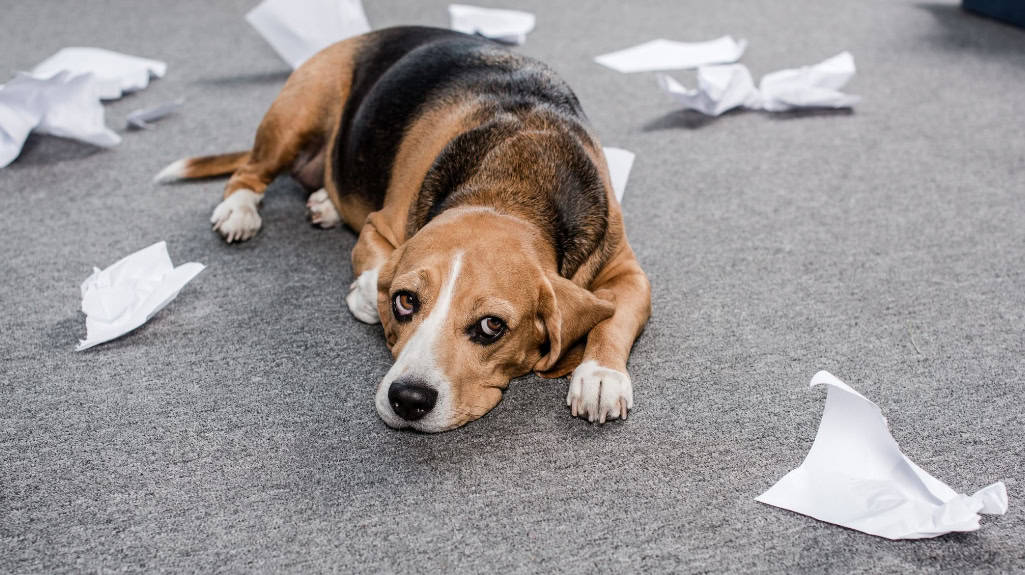
Establish a Consistent Routine
While gradual departure training forms the foundation for reducing separation anxiety, establishing a consistent routine solidifies your dog's sense of security. Dogs thrive on predictability, so create a structured daily schedule that encompasses all aspects of their care.
Start each day with a 30-45 minute morning walk or vigorous play session. This crucial exercise releases pent-up energy, significantly decreasing the likelihood of destructive behaviour when you're gone. Follow this with a regular feeding time, reinforcing the routine.
Incorporate mentally stimulating activities into your dog's day. Use puzzle toys or cardio games to engage both their body and mind. These activities not only tire them out but also provide a positive association with your departure.
As you implement your routine, gradually increase the duration of alone time, slowly does it!
Consider Professional Help
If your dog's destructive behaviour persists despite your best efforts, it's time to consider professional help. Consulting a Vet is crucial to rule out underlying medical conditions that may be fuelling the destructive tendencies, and your behaviourist should also for a vet referral.
Once health issues are addressed, seek guidance from a certified separation anxiety dog trainer or behaviourist who can provide tailored strategies for your specific situation. These experts should do a full behavioural work up and assessment of your dog, and also identify triggers for your dog's destructive behaviour and teach you to teach your dog effective coping mechanisms.
CSATs create customised training plans to address issues like separation anxiety and destructive separation related behaviour.
Early professional guidance is essential to prevent the escalation of destructive behaviours. Trainers can teach you advanced techniques to manage your dog's anxiety and redirect their energy positively, no need for any aversive or harsh methods, and no trainer should reocmmend leaving your dog to cry it out!
Remember, the sooner you get that help the better the long term prognosis for your dog.
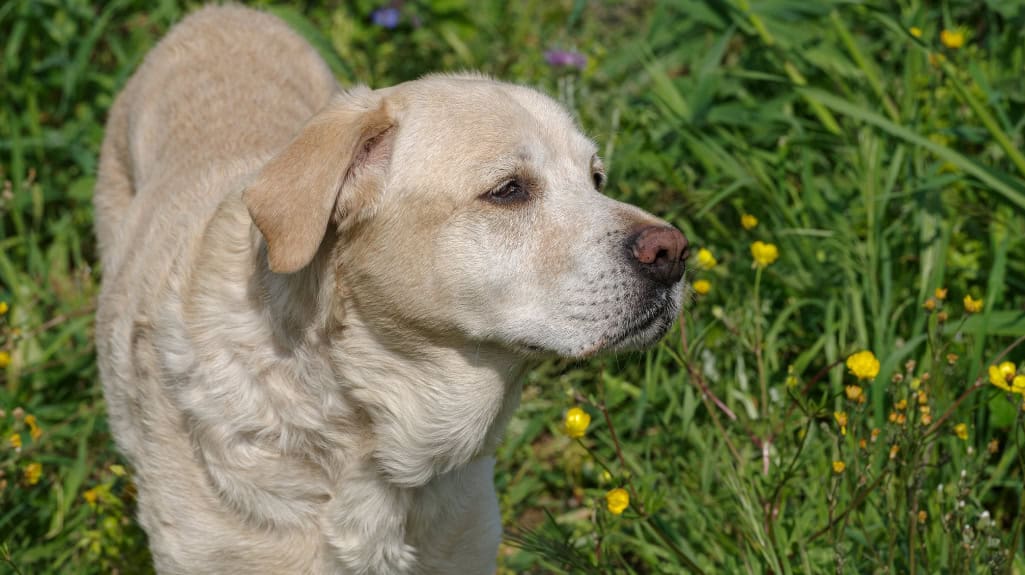
Use Calming Aids
Occasionally, behavioural training alone isn't enough to curb your dog's destructive tendencies. In these cases, calming aids can provide additional support to help your dog cope when home alone. In severe cases I would ask you to speak to your Vet about separation anxiety medication.
Non prescription calming aids, pheromones and natural products are what I call ‘can't hurt, might help' you just need to make sure you're quite methodical and analyse how your dog responds to check for effectiveness.
CBD oil has gained popularity for its ability to rebalance stress hormones, promoting a sense of calm when you're away, there isn't a whole lot of research yet with dogs, and to get a stronger product you'll need to see your Vet.
Calming collars and sprays that release soothing pheromones or aromas like Pet Remedy, can create a more relaxing environment for your dog.
Herbal supplements containing skullcap, valerian root or chamomile, may offer further stress relief. However, it's crucial to consult your veterinarian before introducing any new calming aids to ensure they're safe and appropriate for your dog's specific needs.
There are also other products that contain compounds like Tryptophan or 5HTP, which is the precursor to serotonin, of course if you have a dog who is bored but ecstatic then we need to be quite careful with what changes this can make to brain chemistry.
To maximise effectiveness, calming aids should be used in conjunction with a gradual desensitisation process. Start by using the calming product during short departures, slowly increasing the duration as your dog adjusts. This approach can help your pet develop positive associations with being alone.
Monitor and Adjust Strategies
Through consistent monitoring and adjustment, you'll fine-tune your approach to stopping your dog's destructive behaviour. Utilise remote cameras to observe your pet's actions when you're away, identifying specific triggers and patterns that lead to destruction. This insight allows you to tailor your interventions more effectively.
Regularly assess your dog's energy levels and adjust their exercise routine accordingly. Ensure they receive ample physical and mental stimulation before you depart, as this can significantly reduce anxiety-driven behaviours.
Implement a gradual departure strategy, slowly increasing the duration of your absences to help your dog acclimate to being alone without resorting to destructive habits.
To combat boredom, rotate your dog's toys and introduce new, engaging activities. This variety maintains their interest and prevents them from seeking stimulation through destructive means.
Consistently evaluate the efficacy of your strategies over time. If you're not seeing substantial improvements, don't hesitate to consult a professional trainer or behaviourist. We can provide specialised guidance to address your dog's unique needs and help you refine your approach for optimal results.
Hopefully you've got plenty of tools to tackle your dog's destructive behaviour. Remember, patience is key. Stick to your strategies, and don't be afraid to ask for help if you're not seeing results. Keep a close eye on your pup's progress and celebrate small victories. With time, effort, and understanding, you'll help your dog feel more secure when you're away.
To learn more check out my article on separation anxiety help or how about crate training a dog with separation anxiety?




